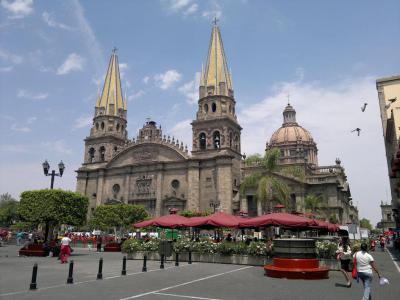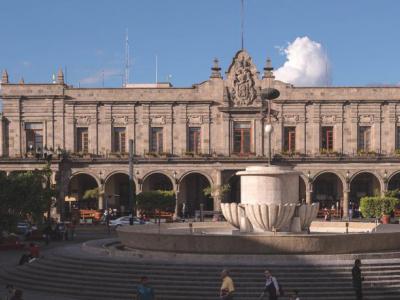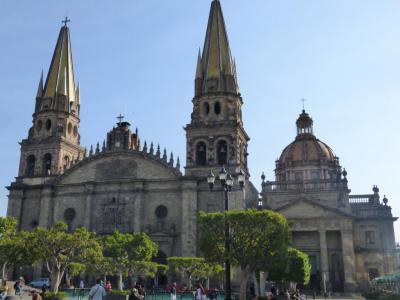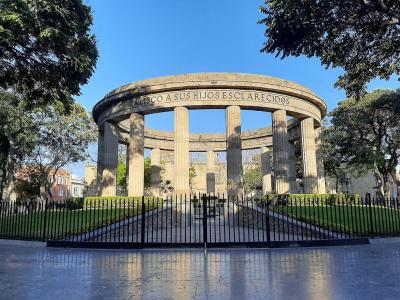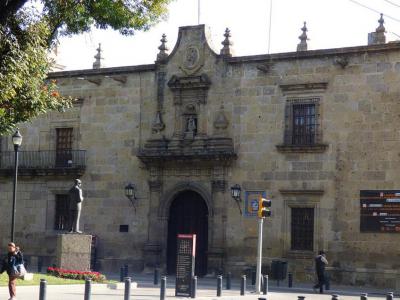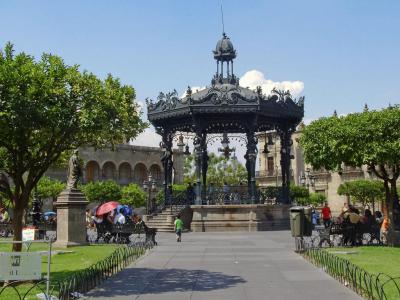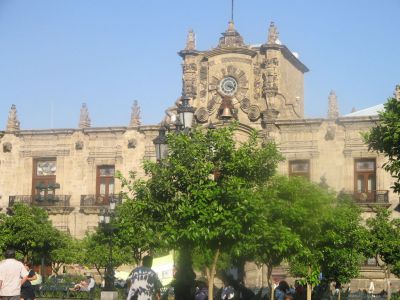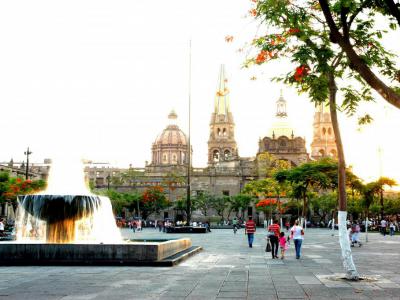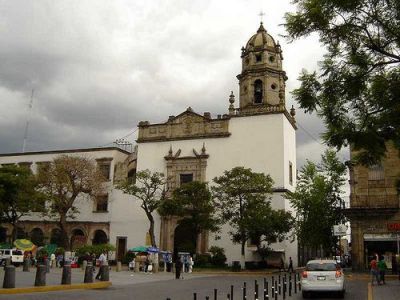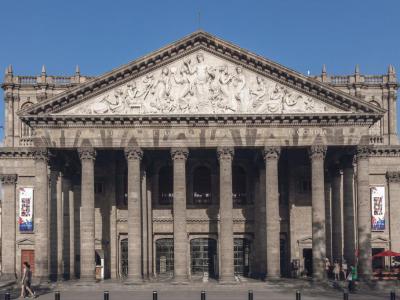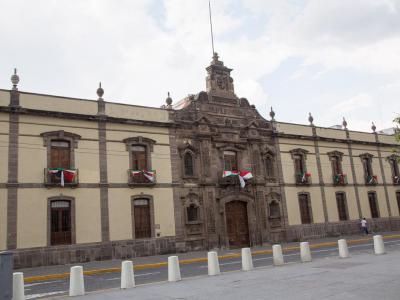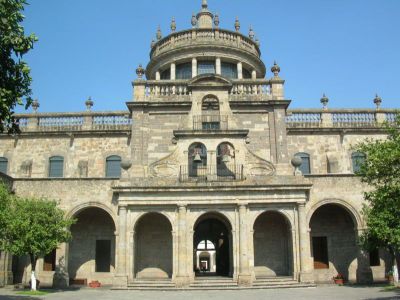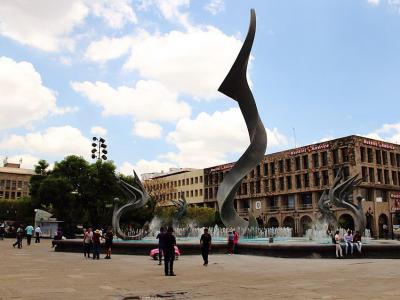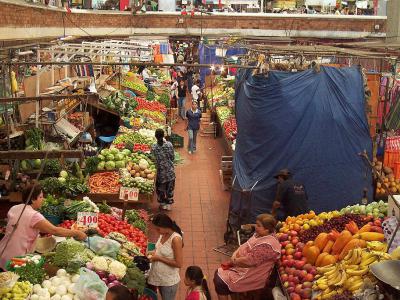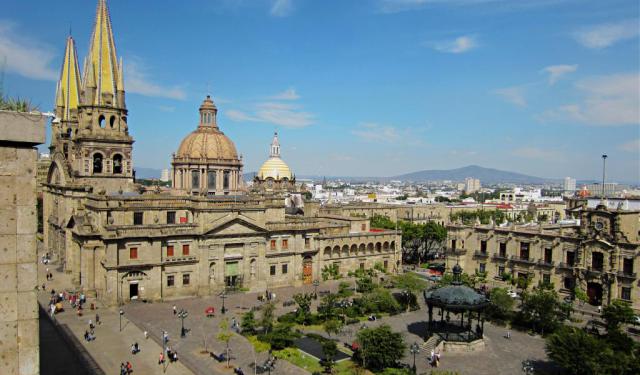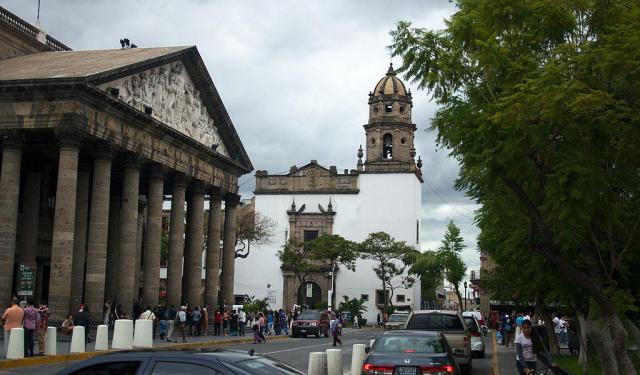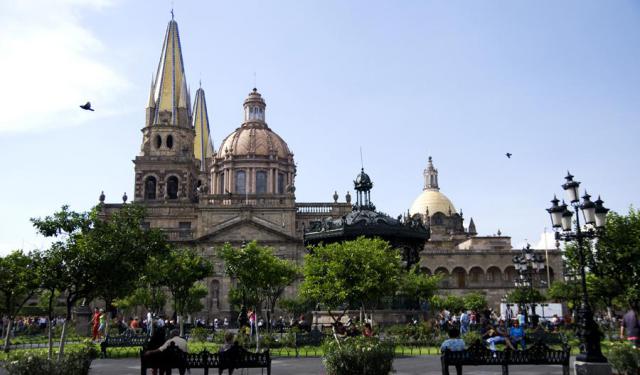
Historical Center Walk (Self Guided), Guadalajara
Guadalajara is a modern, bustling metropolis with a long history. It was founded in 1542 as part of New Spain. The town was named after Spanish conquistador Nuno de Guzman’s hometown in Spain.
The city became Mexican state Jalisco’s largest city and its capital. The town boomed during the 17th century, and it became the nation's second-largest city during the 18th century. Miguel Hidalgo y Costilla founded Mexico’s first independent government in Guadalajara in 1810, and the Abolition of Slavery of the same year was signed here. In 1929, President Plutarco Elías Calles ended the Cristero War in Guadalajara. During the 20th century, Guadalajara experienced steady growth.
Guadalajara has produced several prominent politicians, writers, and revolutionaries. Prominent leaders such as politician Valentin Gomez Farias, writer Agustin Yanez, and Mariano Azuela are memorized at the Rotunda of Illustrious People of Jalisco.
Guadalajara is a global city and a vital producer of Tequilla, Mariachi music, and Birria soup. It's home to several cultural institutions and universities and hosts international festivals like the International Book Fair and the International Film Festival. Guadalajara has even hosted two FIFA World Cup soccer competitions.
Walking around Guadalajara today, you'll see a mix of colonial and modern architecture. San Agustin Church dates to 1573 and is one of the area's oldest and loveliest churches. The Guadalajara Cathedral was built between 1561 and 1618 and features beautiful altars and several important relics. Architecture fans will want to check out the impressive Cabanas Orphanage, a UNESCO World Heritage Site.
The Degollado Theater is one of Mexico’s most celebrated and ornate cultural institutions. Don't miss the Governor’s Palace, which offers a stunning example of Spanish architecture. Several squares feature landmark buildings, beautiful fountains, and great outdoor cafes. Finally, shoppers won’t want to miss Libertad Market, one of Mexico’s largest indoor markets.
Take in Mexico's sights, sounds, and tastes with this self-guided tour to explore Guadalajara’s most notable landmarks.
The city became Mexican state Jalisco’s largest city and its capital. The town boomed during the 17th century, and it became the nation's second-largest city during the 18th century. Miguel Hidalgo y Costilla founded Mexico’s first independent government in Guadalajara in 1810, and the Abolition of Slavery of the same year was signed here. In 1929, President Plutarco Elías Calles ended the Cristero War in Guadalajara. During the 20th century, Guadalajara experienced steady growth.
Guadalajara has produced several prominent politicians, writers, and revolutionaries. Prominent leaders such as politician Valentin Gomez Farias, writer Agustin Yanez, and Mariano Azuela are memorized at the Rotunda of Illustrious People of Jalisco.
Guadalajara is a global city and a vital producer of Tequilla, Mariachi music, and Birria soup. It's home to several cultural institutions and universities and hosts international festivals like the International Book Fair and the International Film Festival. Guadalajara has even hosted two FIFA World Cup soccer competitions.
Walking around Guadalajara today, you'll see a mix of colonial and modern architecture. San Agustin Church dates to 1573 and is one of the area's oldest and loveliest churches. The Guadalajara Cathedral was built between 1561 and 1618 and features beautiful altars and several important relics. Architecture fans will want to check out the impressive Cabanas Orphanage, a UNESCO World Heritage Site.
The Degollado Theater is one of Mexico’s most celebrated and ornate cultural institutions. Don't miss the Governor’s Palace, which offers a stunning example of Spanish architecture. Several squares feature landmark buildings, beautiful fountains, and great outdoor cafes. Finally, shoppers won’t want to miss Libertad Market, one of Mexico’s largest indoor markets.
Take in Mexico's sights, sounds, and tastes with this self-guided tour to explore Guadalajara’s most notable landmarks.
How it works: Download the app "GPSmyCity: Walks in 1K+ Cities" from Apple App Store or Google Play Store to your mobile phone or tablet. The app turns your mobile device into a personal tour guide and its built-in GPS navigation functions guide you from one tour stop to next. The app works offline, so no data plan is needed when traveling abroad.
Historical Center Walk Map
Guide Name: Historical Center Walk
Guide Location: Mexico » Guadalajara (See other walking tours in Guadalajara)
Guide Type: Self-guided Walking Tour (Sightseeing)
# of Attractions: 14
Tour Duration: 2 Hour(s)
Travel Distance: 1.9 Km or 1.2 Miles
Author: Caroline
Sight(s) Featured in This Guide:
Guide Location: Mexico » Guadalajara (See other walking tours in Guadalajara)
Guide Type: Self-guided Walking Tour (Sightseeing)
# of Attractions: 14
Tour Duration: 2 Hour(s)
Travel Distance: 1.9 Km or 1.2 Miles
Author: Caroline
Sight(s) Featured in This Guide:
- Plaza Guadalajara (Guadalajara Square)
- Palacio Municipal (City Palace)
- Catedral de Guadalajara (Guadalajara Cathedral)
- Rotunda of the Illustrious People of Jalisco
- Museo Regional de Guadalajara (Regional Museum of Guadalajara)
- Plaza de Armas (Main Square)
- Palacio de Gobierno (Government Palace)
- Plaza de la Liberación (Freedom Square)
- Templo de San Agustin (San Agustín Church)
- Teatro Degollado (Degollado Theatre)
- Palacio de Justicia (Palace of Justice of Jalisco)
- Hospicio Cabañas (Cabañas Orphanage)
- Plaza Tapatia (Tapatia Square)
- Mercado de San Juan de Dios (Libertad Market)
1) Plaza Guadalajara (Guadalajara Square)
Guadalajara Square is home to City Palace, and visitors can also enjoy views of Guadalajara Cathedral. The square was founded in the 1950s when the City Palace was built. The area had several buildings that were demolished to make room for the palace and plaza. In addition, an underground parking lot was built underneath the plaza.
The square is shaded by laurel trees and was originally called the Laurels Square (Plaza de los Laureles). In 1992, the square was renamed Guadalajara Square to celebrate the city's 450th anniversary.
Guadalajara Square features a large fountain that depicts an oyster shell decorated with rose petals and a single pearl. The fountain celebrates Gudalajara's two nicknames, "The Pearl of the West" and "City of Roses." The fountain also features the city's coat of arms.
The square has several welcoming cafes where visitors can enjoy a break. The original underground parking lot has been transformed into the Plaza Guadalajara Shopping Center.
The square is shaded by laurel trees and was originally called the Laurels Square (Plaza de los Laureles). In 1992, the square was renamed Guadalajara Square to celebrate the city's 450th anniversary.
Guadalajara Square features a large fountain that depicts an oyster shell decorated with rose petals and a single pearl. The fountain celebrates Gudalajara's two nicknames, "The Pearl of the West" and "City of Roses." The fountain also features the city's coat of arms.
The square has several welcoming cafes where visitors can enjoy a break. The original underground parking lot has been transformed into the Plaza Guadalajara Shopping Center.
2) Palacio Municipal (City Palace)
The City Palace was built between 1949 and 1952, but its neoclassical style makes it seem older. The palace has a central courtyard and features colonial-style arches and columns in addition to an ornate staircase. This beautiful building houses Jalisco's city council offices.
Inside, visitors will find the Hall of Presidents and the Hall of Councils. The Hall of Presidents features sculptures of historical figures. Visitors will find sculptures of Manuel Lopez Cotilla, Pedro Moreno, Agustin Yanez, and Clemente Aguirre.
The Hall of Councils features dramatic murals painted by artist Gabriel Flores in 1963. The mural includes five panels that show Guadalajara's history. The scenes show the Spanish conquest, the Mixton War, Guadalajara's founding, the colonial era, and the the oath of the royal banner (Paseo del Pendon).
Visitors can see Guadalajara's coat of arms at the palace's entrance. The Palacio Municipal is open Monday to Friday from 9:00 to 19:00.
Inside, visitors will find the Hall of Presidents and the Hall of Councils. The Hall of Presidents features sculptures of historical figures. Visitors will find sculptures of Manuel Lopez Cotilla, Pedro Moreno, Agustin Yanez, and Clemente Aguirre.
The Hall of Councils features dramatic murals painted by artist Gabriel Flores in 1963. The mural includes five panels that show Guadalajara's history. The scenes show the Spanish conquest, the Mixton War, Guadalajara's founding, the colonial era, and the the oath of the royal banner (Paseo del Pendon).
Visitors can see Guadalajara's coat of arms at the palace's entrance. The Palacio Municipal is open Monday to Friday from 9:00 to 19:00.
3) Catedral de Guadalajara (Guadalajara Cathedral) (must see)
Guadalajara's first cathedral was built in 1541. This cathedral was damaged in a fire, and Phillip II, King of Spain, commissioned a new cathedral. Construction began in 1561 and was completed in 1618. The Spanish Renaissance-style Guadalajara Cathedral was consecrated in 1716.
After earthquakes damaged the cathedral in 1818 and 1849, architect Manuel Gómez Ibarra designed new Neo-Gothic towers. The towers were completed in 1854. Several more earthquakes have damaged the cathedral over the last one hundred years.
Guadalajara Cathedral has eleven altars gifted by King Fernando VII of Spain. The altars are dedicated to Our Lady of Guadalupe, Our Lady of the Assumption, Our Lady of Zapopan, and Our Lady of Sorrows. In addition, there are also altars dedicated to Saint Thomas Aquinas, Saint Nicholas, Saint Dominic, Saint Christopher, and Saint John of God.
The relics of Santa Innocencia are housed in the cathedral. In the 1700s, Santa Innocencia was killed by her father for converting to Catholicism. In addition, the cathedral houses the remains of several prominent cardinals and bishops.
In the Martyrs Relic, you can see the bones of 23 men that died during the Cristero Wars. The Cristero War, also known as the Cristero Rebellion, was a widespread struggle in central and western Mexico against the implementation of secularist and anticlerical articles of the 1917 Constitution. Pope John Paul II beatified these remains in 1992.
Spanish artist Bartolome Murillo painted the beautiful The Assumption of the Virgin in 1650. Emperor Carlos V donated the Virgin of the Roses sculpture.
The 19th-century organ was imported from France and took an entire year to assemble. The beautiful stained glass windows also came from France.
The cathedral has hidden tunnels that were used as escape routes and hiding places.
After earthquakes damaged the cathedral in 1818 and 1849, architect Manuel Gómez Ibarra designed new Neo-Gothic towers. The towers were completed in 1854. Several more earthquakes have damaged the cathedral over the last one hundred years.
Guadalajara Cathedral has eleven altars gifted by King Fernando VII of Spain. The altars are dedicated to Our Lady of Guadalupe, Our Lady of the Assumption, Our Lady of Zapopan, and Our Lady of Sorrows. In addition, there are also altars dedicated to Saint Thomas Aquinas, Saint Nicholas, Saint Dominic, Saint Christopher, and Saint John of God.
The relics of Santa Innocencia are housed in the cathedral. In the 1700s, Santa Innocencia was killed by her father for converting to Catholicism. In addition, the cathedral houses the remains of several prominent cardinals and bishops.
In the Martyrs Relic, you can see the bones of 23 men that died during the Cristero Wars. The Cristero War, also known as the Cristero Rebellion, was a widespread struggle in central and western Mexico against the implementation of secularist and anticlerical articles of the 1917 Constitution. Pope John Paul II beatified these remains in 1992.
Spanish artist Bartolome Murillo painted the beautiful The Assumption of the Virgin in 1650. Emperor Carlos V donated the Virgin of the Roses sculpture.
The 19th-century organ was imported from France and took an entire year to assemble. The beautiful stained glass windows also came from France.
The cathedral has hidden tunnels that were used as escape routes and hiding places.
4) Rotunda of the Illustrious People of Jalisco
The Rotunda of the Illustrious People of Jalisco honors Jalisco's influential residents. The memorial was built in 1951 and was originally called the Rotunda of Illustrious Men. In 2000, teacher Irene Obledo Garcia was honored in the memorial, and the name was updated to The Rotunda of the Illustrious People of Jalisco.
Architect Vicente Mendiola designed the rotunda in a neoclassical style. The rotunda is made of quarry stones and has 17 Doric columns. The center of the memorial features a cauldron. The upper ring around the rotunda features an inscription that can be translated as "To Jalisco's distinguished sons."
The memorial has statues of dozens of prominent Jalisco residents. Most of the residents were writers, musicians, artists, philanthropists, and revolutionaries. In addition, the memorial has 98 urns with remains of famous residents.
The memorial is especially beautiful at night when it's lit with multi-colored lights.
Architect Vicente Mendiola designed the rotunda in a neoclassical style. The rotunda is made of quarry stones and has 17 Doric columns. The center of the memorial features a cauldron. The upper ring around the rotunda features an inscription that can be translated as "To Jalisco's distinguished sons."
The memorial has statues of dozens of prominent Jalisco residents. Most of the residents were writers, musicians, artists, philanthropists, and revolutionaries. In addition, the memorial has 98 urns with remains of famous residents.
The memorial is especially beautiful at night when it's lit with multi-colored lights.
5) Museo Regional de Guadalajara (Regional Museum of Guadalajara)
The Regional Museum of Guadalajara focuses on Guadalajara's history from pre-historic times to the present. The museum is located in an attractive building that features a stunning courtyard and fountain. The building dates to the 1700s and was originally used as a theological seminary. It was converted into a museum in 1918.
The ground floor has a natural history area that features a wooly mammoth skeleton dating to 10,000 BC. The museum has a selection of impressive pre-colonial ceramics. In addition, visitors can see an impressive 1715-pound meteorite that was discovered in 1792.
Other exhibits feature multimedia displays that describe indigenous culture. The museum also displays a replica of a tomb commonly found in western Mexico.
The second floor features colonial paintings depicting religious scenes and the Spanish conquest. In addition, visitors will find paintings by modern Mexican artists Dr. Atl and Diego Rivera.
The museum is open Tuesdays to Sundays from 9:00 to 17:30.
The ground floor has a natural history area that features a wooly mammoth skeleton dating to 10,000 BC. The museum has a selection of impressive pre-colonial ceramics. In addition, visitors can see an impressive 1715-pound meteorite that was discovered in 1792.
Other exhibits feature multimedia displays that describe indigenous culture. The museum also displays a replica of a tomb commonly found in western Mexico.
The second floor features colonial paintings depicting religious scenes and the Spanish conquest. In addition, visitors will find paintings by modern Mexican artists Dr. Atl and Diego Rivera.
The museum is open Tuesdays to Sundays from 9:00 to 17:30.
6) Plaza de Armas (Main Square)
Plaza de Armas is the main square of Guadalajara. It is located directly in the city's historic center. The square offers a variety of sights, such as the Guadalajara Cathedral and the Government Palace.
Mariachi bands frequent the Main Square. Those who wish to stay for a while to take in the vibrant square can do so on one of the many public, wrought iron benches. The rows of trees provide ample shade so even the hottest days can be enjoyed. The square is also lovely at night when it is lit by the lampposts and the lights of Guadalajara Cathedral.
The square was constructed in the late 19th century and remodeled in 1910. The bandstand in the center of the square is an art nouveau, wrought iron bandstand that was gifted by Mexican president Porfirio Diaz. The stage features eight pillars with female figures that represent different musical instruments. It was built in Paris by the Val D'Osne Art Foundries (Fonderies D'art Du Val D'Osne).
Mariachi bands frequent the Main Square. Those who wish to stay for a while to take in the vibrant square can do so on one of the many public, wrought iron benches. The rows of trees provide ample shade so even the hottest days can be enjoyed. The square is also lovely at night when it is lit by the lampposts and the lights of Guadalajara Cathedral.
The square was constructed in the late 19th century and remodeled in 1910. The bandstand in the center of the square is an art nouveau, wrought iron bandstand that was gifted by Mexican president Porfirio Diaz. The stage features eight pillars with female figures that represent different musical instruments. It was built in Paris by the Val D'Osne Art Foundries (Fonderies D'art Du Val D'Osne).
7) Palacio de Gobierno (Government Palace) (must see)
The original Government Palace was built in 1650. However, an earthquake in 1750 destroyed the original adobe building. Governor Don Jose de Basarte commissioned a new building that was designed by Manuel Jose Conique and Nicolas Enrique del Castillo.
The construction was funded by taxes placed on local tequila producers. Spain prohibited any local production of alcohol, so instead of legally producing alcohol and sending tax money to Spain, the local government secretly allowed alcohol production to continue while keeping the tax money for local improvements. The palace was officially inaugurated in 1790.
Government Palace has a magnificent baroque facade with attractive balconies and large windows. The palace features an impressive Doric gate and a large courtyard with colonial-style columns and arches.
The historic Decree for the Abolition of Slavery was signed at the palace in 1810. Every year, the palace commemorates this important event.
President of the Mexican Republic Benito Juarez narrowly escaped assassination in the palace on March 13, 1858.
In the main courtyard's stairwell, visitors can see three murals painted by the renowned Mexican caricaturist and painter Jose Clemente Orozco in 1937.
The construction was funded by taxes placed on local tequila producers. Spain prohibited any local production of alcohol, so instead of legally producing alcohol and sending tax money to Spain, the local government secretly allowed alcohol production to continue while keeping the tax money for local improvements. The palace was officially inaugurated in 1790.
Government Palace has a magnificent baroque facade with attractive balconies and large windows. The palace features an impressive Doric gate and a large courtyard with colonial-style columns and arches.
The historic Decree for the Abolition of Slavery was signed at the palace in 1810. Every year, the palace commemorates this important event.
President of the Mexican Republic Benito Juarez narrowly escaped assassination in the palace on March 13, 1858.
In the main courtyard's stairwell, visitors can see three murals painted by the renowned Mexican caricaturist and painter Jose Clemente Orozco in 1937.
8) Plaza de la Liberación (Freedom Square) (must see)
Freedom Square is dedicated to Miguel Hidalgo, who signed the Abolition of Slavery in 1810. The square features a bronze sculpture showing Miguel Hidalgo breaking the chains of slavery. Hidalgo also led the Mexican War of Independence and is known as the Father of the Nation.
Freedom Square features two impressive fountains designed by Ignacio Díaz Morales. The fountains look like two large cups, and the square is sometimes called Two Cups Plaza (La Plaza de Dos Copas).
Because of its large size, the square hosts many exhibitions and events. The square is also home to a Guadalajara sign, which is a popular backdrop for photos.
Freedom Square has a vibrant market where you can find clothing, pottery, ceramics, art, and souvenirs. The square also has several cafes with outdoor seating so you can grab a refreshment and enjoy people-watching.
Freedom Square features two impressive fountains designed by Ignacio Díaz Morales. The fountains look like two large cups, and the square is sometimes called Two Cups Plaza (La Plaza de Dos Copas).
Because of its large size, the square hosts many exhibitions and events. The square is also home to a Guadalajara sign, which is a popular backdrop for photos.
Freedom Square has a vibrant market where you can find clothing, pottery, ceramics, art, and souvenirs. The square also has several cafes with outdoor seating so you can grab a refreshment and enjoy people-watching.
9) Templo de San Agustin (San Agustín Church)
San Agustin Church is known as Guadalajara's loveliest church. Phillip II of Spain commissioned the baroque church in 1573.
The Augustinian order had wanted its own church for many years, but rival Franciscans rejected the idea. Fray Antonio de Mendoza was put in charge of the new church, and his sister donated funds to build the church. San Agustín Church was built between 1573 and 1674 and features a distinctive gold and white facade.
Augustin convents were usually built facing west. However, the San Agustin Church was built facing north to face the city's main square at that time. The old square disappeared when the Degollado Theater was built in 1866.
The interior is simple and features an altar depicting Saint Augustine and his mother, Saint Monica.
In 1818, a large earthquake destroyed the church, which was rebuilt in 1854. The adjacent former convent now houses the School of Music of the University of Guadalajara.
The Augustinian order had wanted its own church for many years, but rival Franciscans rejected the idea. Fray Antonio de Mendoza was put in charge of the new church, and his sister donated funds to build the church. San Agustín Church was built between 1573 and 1674 and features a distinctive gold and white facade.
Augustin convents were usually built facing west. However, the San Agustin Church was built facing north to face the city's main square at that time. The old square disappeared when the Degollado Theater was built in 1866.
The interior is simple and features an altar depicting Saint Augustine and his mother, Saint Monica.
In 1818, a large earthquake destroyed the church, which was rebuilt in 1854. The adjacent former convent now houses the School of Music of the University of Guadalajara.
10) Teatro Degollado (Degollado Theatre) (must see)
Degollado Theater is a stunning classical-style theater that was commissioned in 1855 and built between 1856 and 1866. When the theater was commissioned, it was called Alarcon Theater after actor Juan Ruiz de Alarcon.
Santos Degollado was Jalisco's governor and laid the theater's cornerstone in 1856. He died in battle in 1861, and the theatre was renamed to honor Degollado in December 1866.
The exterior has grand Corinthian columns. The pediment features a mosaic showing Apollo and the Nine Muses.
Degollado Theater's interior features golden walls with beautiful paintings. Artists Gerardo Suarez and Carlos Villasenor created an impressive mural depicting Dante's Divine Comedy's fourth canto.
Internationally acclaimed opera singer Angela Peralta de Castera sang Lucia of Lammermoor at the theater's opening in 1866. Famous tenor Placido Domingo sang the same opera to commemorate the theater's centennial in 1966.
Today, the theater hosts the Jalisco Philharmonic Orchestra, opera, dance, theater, and artistic festivals.
Santos Degollado was Jalisco's governor and laid the theater's cornerstone in 1856. He died in battle in 1861, and the theatre was renamed to honor Degollado in December 1866.
The exterior has grand Corinthian columns. The pediment features a mosaic showing Apollo and the Nine Muses.
Degollado Theater's interior features golden walls with beautiful paintings. Artists Gerardo Suarez and Carlos Villasenor created an impressive mural depicting Dante's Divine Comedy's fourth canto.
Internationally acclaimed opera singer Angela Peralta de Castera sang Lucia of Lammermoor at the theater's opening in 1866. Famous tenor Placido Domingo sang the same opera to commemorate the theater's centennial in 1966.
Today, the theater hosts the Jalisco Philharmonic Orchestra, opera, dance, theater, and artistic festivals.
11) Palacio de Justicia (Palace of Justice of Jalisco)
The Palace of Justice of Jalisco was originally built in 1588. The palace building was originally used as the main building of the convent and temple of Santa Maria de Gracia. The building was then used for several different institutions until 1952 when it was remodeled and became the state judiciary.
The palace has a central courtyard with orange trees. In the interior, visitors will find several statues and an impressive mural. The statue on the left of the staircase depicts Mariano Otero, who was a writer, politician, and Guadalajara resident. The statue on the right of the staircase shows Ignacio Vallarta, a governor of Jalisco.
Guillermo Chavez Vega painted a famous mural that depicts scenes showing Mexico's history. The mural depicts prominent Mexican leaders Benito Juarez, Melchor Ocampo, and Valentin Gomez Farias. The mural shows Mariano Otero defending the town and Ignacio Vallarta holding a flag. In addition, the mural shows a female figure welding a sword.
The palace has a central courtyard with orange trees. In the interior, visitors will find several statues and an impressive mural. The statue on the left of the staircase depicts Mariano Otero, who was a writer, politician, and Guadalajara resident. The statue on the right of the staircase shows Ignacio Vallarta, a governor of Jalisco.
Guillermo Chavez Vega painted a famous mural that depicts scenes showing Mexico's history. The mural depicts prominent Mexican leaders Benito Juarez, Melchor Ocampo, and Valentin Gomez Farias. The mural shows Mariano Otero defending the town and Ignacio Vallarta holding a flag. In addition, the mural shows a female figure welding a sword.
12) Hospicio Cabañas (Cabañas Orphanage) (must see)
The Bishop of Guadalajara founded the Cabanas Orphanage in the 1700s. Architect Manuel Tolsa designed the current building, which opened in 1810. The orphanage was named after Juan Ruiz de Cabanas, who oversaw the orphanage's construction. The orphanage was built to function as a hospital, workhouse, orphanage, and almshouse. It housed 500 children at a time.
The orphanage was built as a single-level building to make moving children, patients, and the elderly easy. Most of the building is 7.5 meters high (25 feet), but the chapel's dome rises to 32.5 meters high (107 feet). The orphanage's exterior features six Doric columns. The interior has 23 courtyards that are surrounded by hallways.
The building continued to function as a hospital until 1980 when the Cabanas Cultural Institute took over. Hospicio Cabana was designated a UNESCO World Heritage Site in 1997.
Visitors can see several impressive artworks and frescoes in the Cabana Orphanage. The interior features dozens of frescoes painted by renowned Mexican artist Jose Clemente Orozco. One such fresco is the celebrated The Man of Fire, painted between 1936 and 1939. In this mural, a human figure is wreathed in flames, and figures resembling zombies watch from below.
In 2014, Daniel Buren created a series of artworks in the orphanage's courtyards. Buren painted geometric shapes and used bright colors and mirrored structures to distort the traditional surroundings.
Artist Alejandro Colunga created two impressive sculptures outside the orphanage. The sculptures are called The Hall of the Magicians (La Sala de Los Magos) and The Universal Wizards (Los Magos Universales).
The orphanage was built as a single-level building to make moving children, patients, and the elderly easy. Most of the building is 7.5 meters high (25 feet), but the chapel's dome rises to 32.5 meters high (107 feet). The orphanage's exterior features six Doric columns. The interior has 23 courtyards that are surrounded by hallways.
The building continued to function as a hospital until 1980 when the Cabanas Cultural Institute took over. Hospicio Cabana was designated a UNESCO World Heritage Site in 1997.
Visitors can see several impressive artworks and frescoes in the Cabana Orphanage. The interior features dozens of frescoes painted by renowned Mexican artist Jose Clemente Orozco. One such fresco is the celebrated The Man of Fire, painted between 1936 and 1939. In this mural, a human figure is wreathed in flames, and figures resembling zombies watch from below.
In 2014, Daniel Buren created a series of artworks in the orphanage's courtyards. Buren painted geometric shapes and used bright colors and mirrored structures to distort the traditional surroundings.
Artist Alejandro Colunga created two impressive sculptures outside the orphanage. The sculptures are called The Hall of the Magicians (La Sala de Los Magos) and The Universal Wizards (Los Magos Universales).
13) Plaza Tapatia (Tapatia Square)
Tapatia Square is a bustling urban square near the center of Guadalajara. The large square is comprised of other smaller squares, the Central Esplanade and the Paseo del Hospicio. There are a number of places to shop and eat around the square. There is also ample room for resting while in the midst of exploring the city.
The square is known as the home of the Immolation of Quetzalcoatl fountain and sculpture by artist Victor Manuel Contreras. The sculpture has the appearance of a lightning bolt. It was inspired by what may have been the final immolation of Quetzalcoatl who was said to have gone to hell to bring fire to the sun.
Four smaller sculptures surround the main sculpture. These represent the four cardinal points. This is adorned by a flower-shaped fountain whose purpose is to make the sculpture appear as if it is in flight.
The square is known as the home of the Immolation of Quetzalcoatl fountain and sculpture by artist Victor Manuel Contreras. The sculpture has the appearance of a lightning bolt. It was inspired by what may have been the final immolation of Quetzalcoatl who was said to have gone to hell to bring fire to the sun.
Four smaller sculptures surround the main sculpture. These represent the four cardinal points. This is adorned by a flower-shaped fountain whose purpose is to make the sculpture appear as if it is in flight.
14) Mercado de San Juan de Dios (Libertad Market)
Libertad Market is one of Mexico's largest covered markets, with around 40,000 square meters of shopping space. Shoppers can find all sorts of goods, arts, and crafts at over 2,800 stands.
The market was designed by architect Alejandro Zohn and first opened in 1958.
Shoppers will find endless groceries such as fresh fruits and vegetables. Visitors can shop for clothing items such as leather coats, sweaters, and embroidered clothes. You'll find other household and fashion items such as cozy blankets, shoes, and attractive bags. In addition, you can find items like electronics, movies, and music.
Stalls sell different crafts using materials such as silver, blown glass, ceramic, leather, and palm leaves. Shoppers can find arts and crafts from a variety of Mexican regions.
On the second floor, visitors will find various restaurants focused on Mexican dishes like torta ahogadas, pozole, and tacos.
The market was designed by architect Alejandro Zohn and first opened in 1958.
Shoppers will find endless groceries such as fresh fruits and vegetables. Visitors can shop for clothing items such as leather coats, sweaters, and embroidered clothes. You'll find other household and fashion items such as cozy blankets, shoes, and attractive bags. In addition, you can find items like electronics, movies, and music.
Stalls sell different crafts using materials such as silver, blown glass, ceramic, leather, and palm leaves. Shoppers can find arts and crafts from a variety of Mexican regions.
On the second floor, visitors will find various restaurants focused on Mexican dishes like torta ahogadas, pozole, and tacos.
Walking Tours in Guadalajara, Mexico
Create Your Own Walk in Guadalajara
Creating your own self-guided walk in Guadalajara is easy and fun. Choose the city attractions that you want to see and a walk route map will be created just for you. You can even set your hotel as the start point of the walk.
Squares of Guadalajara
The historic center of Guadalajara is the oldest part of the city, a place where it was founded. The abundance of handsome colonial landmarks here – old buildings, public parks and squares (plazas) – makes the area truly magnificent. The plazas – popular gathering spots filled with fountains, statues, benches and food stalls – are particularly great for having a break, watching people and... view more
Tour Duration: 1 Hour(s)
Travel Distance: 1.3 Km or 0.8 Miles
Tour Duration: 1 Hour(s)
Travel Distance: 1.3 Km or 0.8 Miles
Guadalajara Historical Churches Walking Tour
Guadalajara, Mexico, is home to a great number of wonderful religious sites, dating back to the colonial era. Many of them are unique architectural treasures, with striking façades and equally impressive interiors.
The Expiatory Church, characterized by its neo-Gothic design, is a striking landmark dedicated to expiation and reparation. Meanwhile, the Our Lady of the Pilar Church boasts... view more
Tour Duration: 2 Hour(s)
Travel Distance: 3.1 Km or 1.9 Miles
The Expiatory Church, characterized by its neo-Gothic design, is a striking landmark dedicated to expiation and reparation. Meanwhile, the Our Lady of the Pilar Church boasts... view more
Tour Duration: 2 Hour(s)
Travel Distance: 3.1 Km or 1.9 Miles
The Most Popular Cities
/ view all
